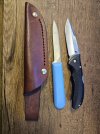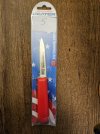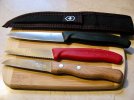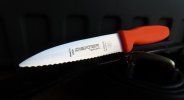screened porch
Basic Member
- Joined
- Feb 19, 2012
- Messages
- 19,313
Partly a matter of taste, maybe, and partly a matter of what you expect to do with a knife.for knife tasks (whittling, peeling and field dressing, deboning, etc.) a little blade flex is desireable. Also, a thin blade slices better than a thick blade.
G.W. Sears (Nessmuk) promoted a blade with a little flex over the (even in his day) gaining in popularity stiff, no flex "Bowie" style "hunting knives".
I don't know what Mr. Kephart's view on the matter was.
AGR said his white-tail and bird-n-trout were harking back to the days when hunters wanted their knives thin and sharp. Both are discontinued, as far as I know.
Kep and Nessmuk were never without a hatchet or axe, so they didn't do a lot of chopping or batonning with their knives.
Someone once wrote, look how thin a machete is, and what it does. Do you really need a fat spine on your belt knife?
Juan Matus carried a "small, serrated knife" that I suspect was a Vic paring knife, but he lived in a desert.
Our pioneering ancestors used mostly ordinary kitchen/butcher knives which weren't very thick, but people sure liked Bowies.
For myself, as an armchair adventurer, I don't give a knife much chance to break, and I have plenty of knives to spare, but one of my favorites is the CS Master Hunter, with its thick spine ground flat to a sharp edge.
Bigger than a paring knife, though.
[More than anyone will want to read, and written without pretense of authority.]
[Edited dessert to desert. Don Juan didn't live in a cake.]
Last edited:






